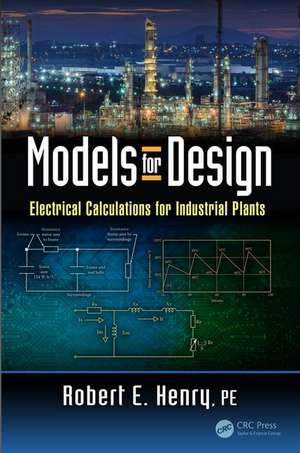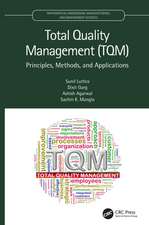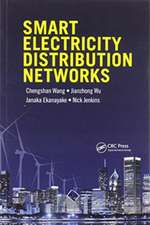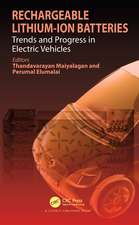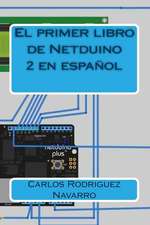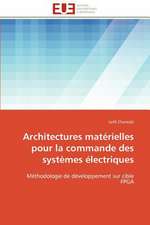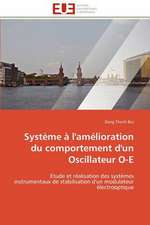Models for Design: Electrical Calculations for Industrial Plants
Autor Robert E. Henry PEen Limba Engleză Hardback – 30 noi 2017
| Toate formatele și edițiile | Preț | Express |
|---|---|---|
| Paperback (1) | 324.16 lei 6-8 săpt. | |
| CRC Press – 12 dec 2019 | 324.16 lei 6-8 săpt. | |
| Hardback (1) | 846.50 lei 6-8 săpt. | |
| CRC Press – 30 noi 2017 | 846.50 lei 6-8 săpt. |
Preț: 846.50 lei
Preț vechi: 1139.72 lei
-26% Nou
Puncte Express: 1270
Preț estimativ în valută:
161.98€ • 169.90$ • 134.84£
161.98€ • 169.90$ • 134.84£
Carte tipărită la comandă
Livrare economică 01-15 aprilie
Preluare comenzi: 021 569.72.76
Specificații
ISBN-13: 9781138504684
ISBN-10: 1138504688
Pagini: 183
Ilustrații: 14 Line drawings, black and white; 25 Tables, black and white
Dimensiuni: 156 x 234 x 17 mm
Greutate: 0.39 kg
Ediția:1
Editura: CRC Press
Colecția CRC Press
ISBN-10: 1138504688
Pagini: 183
Ilustrații: 14 Line drawings, black and white; 25 Tables, black and white
Dimensiuni: 156 x 234 x 17 mm
Greutate: 0.39 kg
Ediția:1
Editura: CRC Press
Colecția CRC Press
Public țintă
Professional Practice & DevelopmentCuprins
Introduction. Part I: Plant Equipment. Using an Uninterruptable Power Supply to Power a Variable Speed Drive. Storage Batteries. Part II: One-Line Designs. The Largest Demand for 13.8 kV Switchgear. The Minor Influence of the Grid Thevenin Impedance on Plant Faults. Use of a Three-Winding Step-up Transformer. Part III: Fast Transient Calculations. Analysis of Power Cables Conducting Fast Transient Loads. Sizing Power Cables for Fast Transient Loads. Introduction to Motor Analysis. Fast Transient Motor Analysis. Calculation of Motor Temperatures. Motor Conclusions. Line Design. Comparisons of Line Alternative Costs. Preliminary Cost Estimate. Appendix A Cable Transient Temperature Rise. Appendix B Finding the Electrical Characteristics of the 400 Hp Motor.
Notă biografică
Robert E. Henry, PE, has fifty-five years of engineering experience. His early years were in aerospace, designing military electronics and spacecraft. He worked in the Apollo Program in design of the Lunar Module. Most of his experience was spent in electrical power with utilities and engineering companies. He is a graduate electrical engineer, and he holds a Master’s degree in management. His design experience has been with commercial buildings, with power generating plants both in the US and abroad, with transmission substations, with electrical equipment manufacturing, with the food industries, in oil refineries, in mining and metals, in paper production, and in nuclear plant design. He has held the positions of senior engineer, lead engineer, group supervisor, department head, director of engineering, and principal. He retired in 2013 from Bechtel Corp. after eleven years of service. He now has his own consulting company in the Houston area. He was an adjunct professor with Washington State University in the engineering school and with Des Moines Iowa Community College. His publications are in circuit design, in orbital rendezvous and in power engineering with interest in kiloampere loads lasting several minutes. He is a Korean War veteran with the USAF.
Recenzii
"Bob Henry has used his extensive experience and knowledge to address calculations for electrical engineering in industrial plants. He has shown the calculations for using an uninterruptible power supply to power large motors driven by a variable frequency drive which is the first time I have seen it addressed in a textbook. This is a unique application that having the calculations to size the units and show the operation will be very helpful in operating plants."
— David E Nelson, Senior Electrical Engineer
— David E Nelson, Senior Electrical Engineer
Descriere
This book instructs the reader on how to size a network’s equipment and address requirements for fast-transient loads (kiloampere loads that last for several minutes). It explores specific calculations used to design equipment for plants. The chapters discuss economic design methods and dynamic-load requirements for electrical equipment.
